Digital Poster
Peak to Peak: MR Spectroscopy
ISMRM & ISMRT Annual Meeting & Exhibition • 10-15 May 2025 • Honolulu, Hawai'i

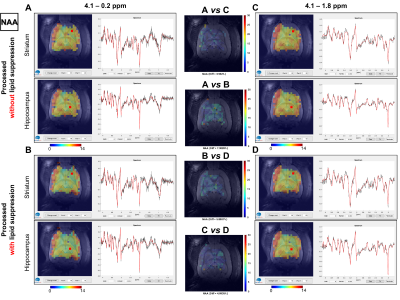 |
Computer Number: 65
2930. Retrospective
lipid removal in preclinical 1H-FID MRSI at ultra-high field and
potential effects on metabolite concentration estimates
T. T. Phan, B. Alves, T. P. Lê, A. Klauser, B. Lanz, C.
Cudalbu
CIBM Center for Biomedical Imaging, Lausanne, Switzerland
Impact: Our work is evaluating the retrospective lipid
suppression on metabolite estimates at 14.1T in the rat
brain for 1H-FID-MRSI.
When using low lipid contaminated data, an effect on
concentration estimates was observed, highlighting the need
for future investigations.
|
|
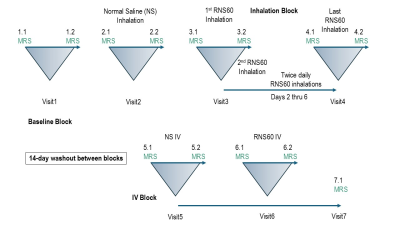 |
Computer Number: 66
2931. Phosphocreatine
recovery kinetics as a biomarker to assess therapies targeting
mitochondrial function
M. Sammi, J. Purnell, C. Butler, E. Baetscher, K. Powers, J.
Mock, S. Ghosh, A. Kalmes, W. Rooney
Oregon Health & Science University, Portland, United States
Impact: The acute effect on mitochondrial function by
RNS60 requires further studies to investigate possible
mechanisms of action. kPCr,
a non-invasive and quantitative measure, can be applied as a
biomarker in other therapies targeting mitochondrial
function.
|
|
 |
Computer Number: 67
2932. Brain
Atlas of Macromolecular Spectroscopic Signals from Ultrashort-TE
MRSI
Y. Zhao, Y. Li, W. Jin, R. Guo, Y. Li, J. Luo, Z-P Liang
University of Illinois at Urbana-Champaign, Champaign, United States
Impact: The proposed method may lead to more accurate
modelling of macromolecule signals, thus improving the
quantification of metabolites in short-TE MRSI.
|
|
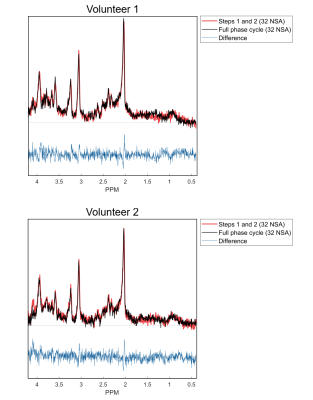 |
Computer Number: 68
2933. Improving
Temporal Resolution in fMRS: Assessing Reduced Phase Cycling in
semi-LASER MRS
A. Ensworth, J. Kramer, E. MacMillan, C. Laule
The University of British Columbia, Vancouver, Canada
Impact:
This study demonstrates the impact of reducing phase cycles in MRS and provides guidance on how to reduce phase cycles to enhance temporal resolution and improve the feasibility of fMRS in clinical and research settings. |
|
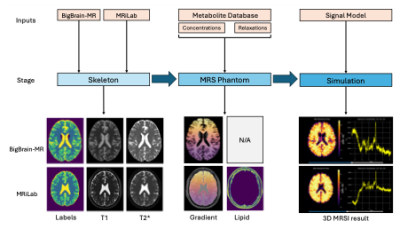 |
Computer Number: 69
2934. A
Digital Phantom for 3D MR Spectroscopy Data Simulation
D. van de Sande, A. Gudmundson, C. Davies-Jenkins, D.
Simicic, G. Simegn, I. Özdemir, S. Amirrajab, J. Merkofer,
H. Zöllner, G. Oeltzschner, R. Edden
Eindhoven University of Technology, Eindhoven, Netherlands
Impact: This MRS phantom framework provides a flexible,
tissue-specific model for realistic MRS and MRSI dataset
simulation. Its modular design allows for precise control
over the parameters and the simulation process to support a
wide range of research and development applications.
|
|
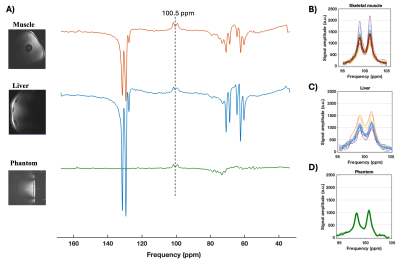 |
Computer Number: 70
2935. Repeatability
of 13C-MRS for absolute glycogen content quantification in the
human liver and skeletal muscle at 7T
P. Veeraiah, C. Fuchs, R. Voncken, K. Brouwers, J. Hurk, J.
Wildberger, P. Thelwall, J. Prompers, L. Loon
Scannexus (Ultra-High Field MRI Center), Maastricht, Netherlands
Impact: 13C-MRS
at 7T showed good repeatability for absolute glycogen
quantification in human liver and muscle, which is promising
for its clinical applicability to measure
intervention/disease related changes in glycogen content.
|
|
 |
Computer Number: 71
2936. Phosphorylated
metabolite T1 relaxation times measured in the macaque brain
using 31P MRS at 11.7T
A. Lopez Kolkovsky, M. Gay, M. Roustan, T. Lilin Froment, A.
Amadon, F. Mauconduit, F. Boumezbeur
CEA, Gif-sur-Yvette, France
Impact: Knowledge of the T1 relaxation
times will play a key role in 31P
metabolite quantification and in determining the optimal
acquisition parameters for 31P
MRSI measurements in the macaque brain at 11.7T.
|
|
 |
Computer Number: 72
2937. The
Differences in Macromolecular Binding Between Sodium and
Potassium Ions
Y. Chen, Y. Yin, J. Xia, H. Li, X. Kong
Institute of Translational Medicine, Shanghai Jiao Tong University, Shanghai, China
Impact: The analysis of ion interactions with
macromolecules may help explain the distinct functions of
sodium and potassium ions in biological systems.
|
|
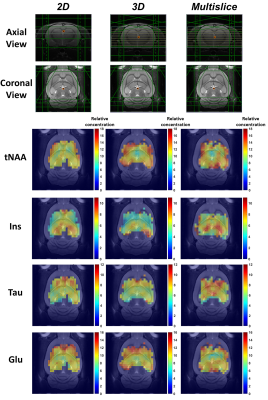 |
Computer Number: 73
2938. First
implementation of fast 1H 3D-FID-MRSI on the rodent brain at
9.4T for metabolite mapping
B. Alves, T. Lê, B. Strasser, W. Bogner, B. Lanz, C. Cudalbu
Centre d'Imagerie Biomedical - CIBM, Lausanne, Switzerland
Impact: 3D
and multislice 1H-FID-MRSI
can offer greater insight in the rat brain metabolism,
enabling finer description of neurodegenerative diseases
within preclinical models, such as the bile duct ligation
rat model for hepatic encephalopathy.
|
|
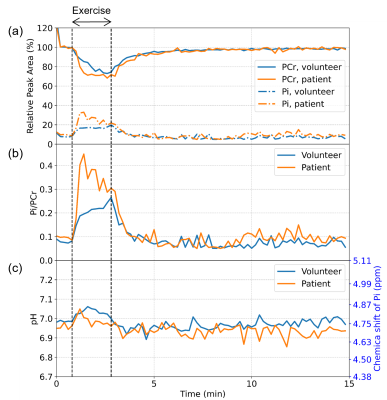 |
Computer Number: 74
2939. Investigation
of exercise-induced skeletal muscle energy metabolism in
patients with cirrhosis using dynamic 31P-MRS on a clinical MRI
system
J. Kwon, K. Ozaki, Y. Katsumata, S. Funayama, S. Ichikawa,
M. Cauteren, S. Goshima
Philips Japan, Tokyo, Japan
Impact:
Metabolic parameters derived from dynamic 31P−MRS in clinical setting showed a different trend in patients with cirrhosis compared to those of healthy volunteers. It may be possible to early identify cirrhotic patients at risk of developing sarcopenia. |
|
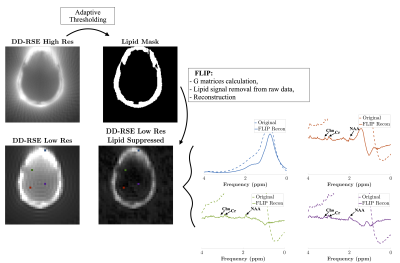 |
Computer Number: 75
2940. A
dual density rosette trajectory for rapid MRSI of the brain with
a simultaneously acquired high-resolution anatomical reference
E. Kadalie, L. Burki, K. Hara-Lee, J. Near
Sunnybrook Research Institute, Toronto, Canada
Impact: A novel acquisition method was developed to
simultaneously collect MRSI data and high-resolution spatial
priors to suppress spectral lipid contamination. This
technique thus has the potential to become a robust clinical
tool for studying metabolic changes in the brain.
|
|
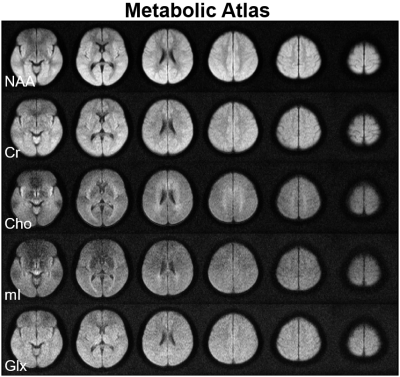 |
Computer Number: 76
2941. Denoising
MRSI Data Using Atlas-Based Statistical Subspaces
W. Jin, Y. Zhao, Y. Li, R. Guo, Y. Zhang, Z. Xu, J. Luo, Y.
Li, Z-P Liang
Beckman Institute for Advanced Science and Technology, University of Illinois at Urbana-Champaign, Urbana, United States
Impact: This
proposed method significantly improved the sensitivity of
brain MRSI using atlas-based statistical subspaces. The
method may further enhance the reliability and practical
utility of high-resolution MRSI techniques.
|
|
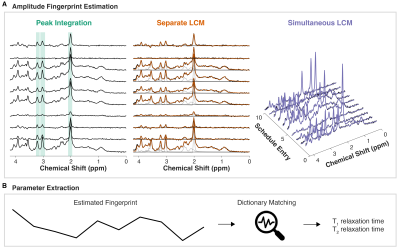 |
Computer Number: 77
2942. MRS
fingerprinting combined with multi-dimensional
linear-combination modeling for fast and accurate
multi-metabolite relaxometry.
H. Zöllner, C. Davies-Jenkins, D. Simicic, J. Stabinska, G.
Oeltzschner, R. Edden, P. Barker
The Johns Hopkins University School of Medicine, Baltimore, United States
Impact: MRSF combined with linear-combinaiton modeling
enables accurate cohort-mean relaxation time estimation for
five metabolites suitable for quantification in large
studies, while conventional MRSF (using simple peak
integration) may better detect small subject-specific
changes in singlet relaxation times.
|
|
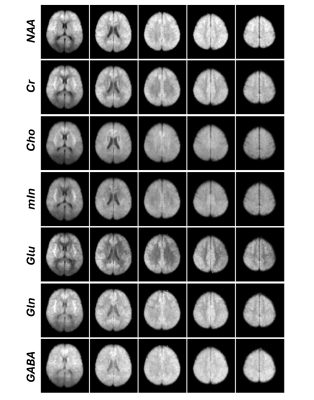 |
Computer Number: 78
2943. Probabilistic
Atlas-Based Image Reconstruction for Ultrafast MR Spectroscopic
Imaging
Y. Li, Y. Zhao, W. Jin, R. Guo, S. Luo, Y. Li, V.
Kindratenko, M. Anastasio, B. Sutton, Z-P Liang
University of Illinois at Urbana-Champaign, Urbana, United States
Impact: With the capability to reduce imaging
dimensionality and improve SNR, the proposed method can
further accelerate MRSI scans, making high-speed
high-resolution MRSI possible for practical applications.
|
|
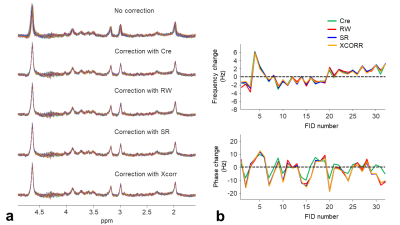 |
Computer Number: 79
2944. Evaluating
real-world performance of retrospective frequency correction in
large samples for single-voxel MR spectroscopy at 7T
C-Y Lee, J. Xu, B. Yang, V. Magnotta
The University of Iowa, Iowa City, United States
Impact: This study demonstrates subjection
motion-induced frequency changes affect certain metabolites
with small concentrations rather than affecting major
metabolites as in the presence of gradient heating-induced
frequency drift. The resulting increased rCRLB of
metabolites can be mitigated using retrospective frequency
corrections.
|
|
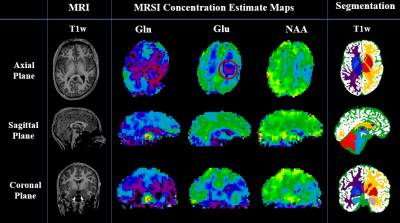 |
Computer Number: 80
2945. An
initial report of quantitative analysis of segmented whole-brain
MRSI in epilepsy
H. Shayeste, S. Chambers, P. Lazen, M. Tomschik, J. Wais, G.
Kasprian, L. Haider, L. Hofer, C. Baumgartner, J. Koren, M.
Feucht, C. Dorfer, E. Pataraia, W. Bogner, S. Trattnig, K.
Rössler, G. Hangel
Department of Neurosurgery, Medical University of Vienna, Vienna, Austria
Impact: For the first time, we established regional
concentration estimates of neurochemicals in epilepsy
patients using 7T MRSI. Detecting abnormal concentrations
could improve the diagnostic performance in MR-negative
patients.
|
The International Society for Magnetic Resonance in Medicine is accredited by the Accreditation Council for Continuing Medical Education to provide continuing medical education for physicians.